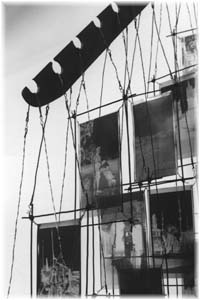![[Metroactive Arts]](/arts/gifs/art468.gif)
![[Metroactive Arts]](/arts/gifs/art468.gif)
[ Arts Index | Metro | Metroactive Central | Archives ]
The Realm of Memory
Lisa Ramirez and Beverly Rayner explore intimate worlds at the Institute of Contemporary Art
By Ann Elliott Sherman
SHARING THE GALLERY at the San José Institute of Contemporary Art are two artists who create skillfully crafted mixed-media works that beckon the viewer to come closer, to learn secrets. Though both are chroniclers of personal and family history, each employs a completely different approach and aesthetics.
Lisa Ramirez's My Abuelita Was Irish series acknowledges the different strata of images, experience and information that fashion memory and a life story. Small books open for perusal become window boxes of private mementos, cut and inset with scrapbook snapshots of friends or family. Sometimes, the insets are photographic self-portraits printed on transparencies and layered over the text of the inside story.
Even when these self-portraits spotlight a breast or the crook of the neck--places usually explored in an erotic context--Ramirez obfuscates as much as she reveals. A blurred focus, obtusely angled perspective or obscured surface maintains an aura of mystery while preserving the essentially private nature of these works. The sensation is not unlike waking up with a lover who remains a stranger despite the most intimate of exchanges.
The body--the ultimate vessel of personal history--holds everything together. The recurrent yonic oval shape and the dominance of heavily lacquered, blood-red backgrounds give rise to a sense that these pieces have been excised from deep within. Another repeated motif is the spine. Transformed from the bookbinding definition to the anatomical, or placed to run down the center of a shield/vagina icon, the spine makes tangible the central foundation laid by these aspects of history or self. It also underscores the fact that emotional reactions rely upon sensory messages.
On top of the painted surfaces, Ramirez puts yet another layer. Organic materials such as snakeskin, seeds or body hair serve as an insistent grounding reminder that we are creatures of earth, that memory--often relegated to a separate realm of intellect--is both dynamic and physical.
All these elements--the book of remembrance, incorporation of text and family photos, the female opening as gateway--have been used before, but Ramirez avoids the hackneyed or predictable precisely because she refuses to avoid ambiguity or to limit the number of levels at work. She has taken the multiple fluency implied by the show's title and turned it into a distinctive asset.
BEVERLY RAYNER, on the other hand, pares down her marriage of found objects and family photos to a minimalist elegance. Convolutions of Time and Memory consists of a wall grid of "peeled" black-and-white 1950s family snapshots delicately threaded like drumheads onto old bedsprings.
The scenes--a first birthday party, vacations, Dad and Gramps playing Monopoly--hover like isolated cartoon thought-bubbles. It's up to the viewer to figure out who's who in the repeated cast of characters; beyond the titles and hinting choice of domestic hardware, Rayner supplies no commentary.
Fading Recollection is reminiscent of childhood picture-puzzle blocks, with its old photos mounted on tiny squares arranged into a rectangle centered within a gessoed wooden frame. Layered with wax and rubbed nearly bare, the piece suggests a worn heirloom quilt pieced out of scraps of memory.
Rayner plays with the sculptural possibilities of photo display in works like Only the Ghosts Remain--vintage negatives attached at the corners to frames of cut wire threaded together and hung like chains from a red clothing-display bracket--and All Eyes Upon You. The latter piece consists of a stained silk lampshade mounted on the wall by its top to form a 3-D frame for a wooden disc embedded with cutout, beeswax-covered photos of pairs of eyes. This theme continues with Secrets, a narrow vertical box smoothed with black lacquer and inlaid with tiny mouths under sepia Plexiglas.
The control and restraint inherent in these formal expressions are pronounced. Rayner seems focused on an exquisite realization of form, with meaning remaining contextual, almost like an emotional undercurrent in a structured musical composition.
As a result, the pieces are dependent upon the implications of feelings associated with family snapshots, with viewers left to cipher what they will. Resisting direct interpretation or narrative, Rayner's new works take personal, sentimental material and deconstruct it into an ineffable idea of family.
[ Metro | Metroactive Central | Archives ]

Only the Ghosts Remain: A detail from one of Beverly Rayner's mixed-media memory works.
Lisa Ramirez: My Abuelita Was Irish and Beverly Rayner: New Works run through Sept. 27 at the San José Institute of Contemporary Art, 451 S. First St., San Jose. (408/283-8155)
From the Sept. 11-17, 1997 issue of Metro.